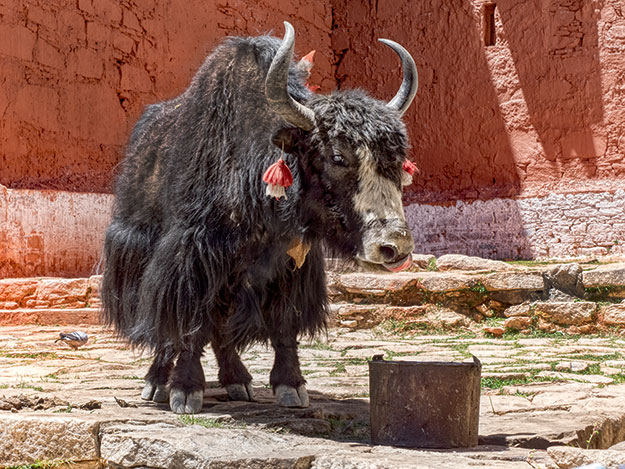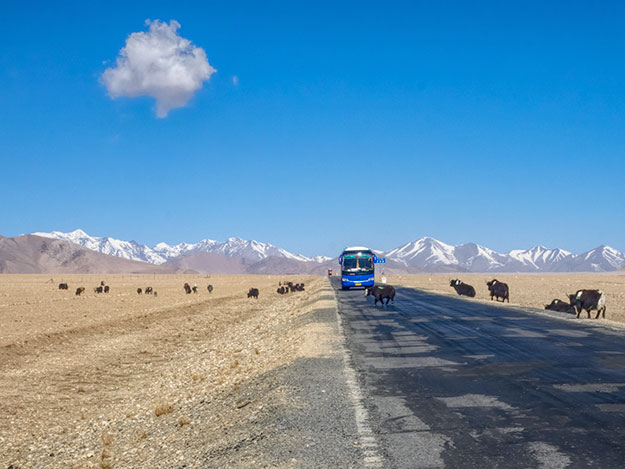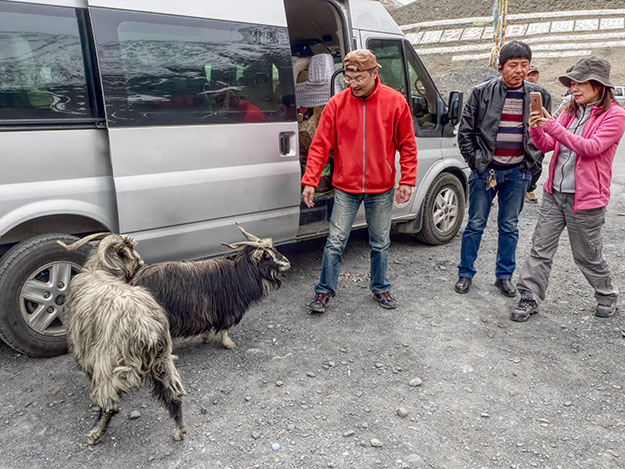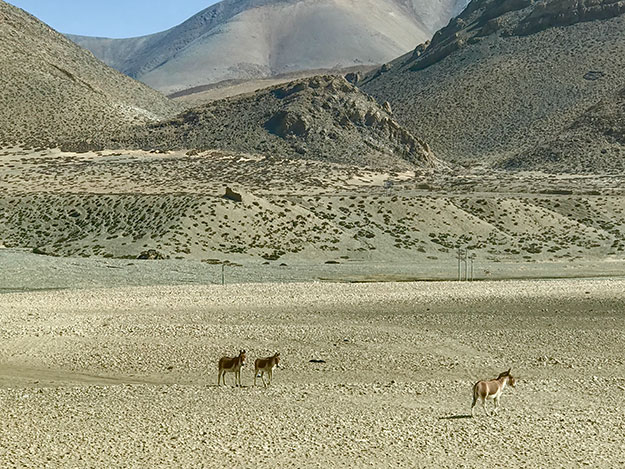One of my most indelible memories from India is of cows wandering the streets with impunity, protected by their holy status. Likewise, in Pokhara, Nepal, I was alarmed the first time I shared a sidewalk with a herd of buffalo. But humans are an adaptable species. After many visits to India and Nepal, freely wandering cows and buffalo seemed commonplace to me. In fact, I thought such cultural differences no longer had an ability to surprise me. Until I came face-to-face with unique species of Tibetan animals on a recent overland journey through the high Tibetan plateau.
It began on the drive from Lhasa airport to the city center. Just as we reached the outskirts, a herd of shaggy black beasts sauntered in front of my car and stopped traffic on the highway. “What are they?” I squealed. “Those are just yaks,” my driver replied. I scrambled for my camera but couldn’t get to it in time. However I soon learned that this wouldn’t be my last opportunity to see yaks.

Perhaps more than any other Tibetan animals, yaks define the culture of Tibet. Products from yaks are used to feed, clothe, and provide shelter typical Tibetan families. Their skulls and horns are carved into combs and pipes. Coarse hair from their backs is woven into tents that block out the chill winds of the high plateau. The finer hair found lower on the yak’s body is woven into clothes and accessories such as shoes, carpets, string, and bags. Cushions made from the yak’s skin generally line the floor inside a Tibetan tent. Their dung is molded into patties that, when dry, are used as fuel to heat the tent and cook. Their tails are used as brooms, and of course, their meat and milk are nutrient rich foods that are crucial to existing in the thin mountain air. Butter churned from their milk is essential for butter lamps used in Buddhist religious ceremonies.

Yaks are so important that they are treated like cherished members of the family. In some cases, they even provide the only means of transportation available to Tibetans. Rural farming families generally have dozens of yaks. Each is given a name based on its appearance. A nomadic family’s yaks are essential for transporting tents and possessions as they move seasonally between pastures.

Farmers also use yaks to plow the fields in the summer and harvest crops in the fall, although more often the beasts yoked to a plow are a cross between a yak and a cow known as a Dzo. As they are a hybrid, the Dzo are heartier and stronger than either cattle or yaks. Farmers attach red headdresses to their horns each spring as an offering believed to ensure a fruitful harvest.

While yaks and dzo may be the most unique Tibetan animals, they are by no means the only ones. Tibetan Mastiffs, a breed that has been used as guard dogs for centuries in Tibet, are renowned for their massive heads, immense size, and their ferocity. The American Kennel Club calls them an “ancient breed,” adding that it is impossible to know how or when they first came into being. I saw my first Mastiff when our tour bus pulled into an overlook. Normally, getting close to one of these behemoths risks losing an arm or a leg, but in this case the owners had “gentled” the dogs. Tourists are invited to have their photos taken with the beasts.

Normally, I wouldn’t pay for such a photo, but I just couldn’t resist. When would I ever see another Tibetan Mastiff? With permission from one of the dogs’ owners, I cautiously sat between a pair of them. I reached out for the black one, dug my nails down deep into his lion-like mane, and began to scratch. Oh, he loved that! The moment I stopped he nudged me with his massive head. I turned to the golden brown one and did the same. He nuzzled my neck with his his cold, wet nose and plopped his giant paw on my shoulder when I stopped.

Another day we stopped next to the Yellow River just as a shepherdess was moving her herd of sheep and goats from the shores of the river into the adjacent hills. She whirled her Wrdo, a long leather slingshot made from sheep hide, and with a flick her the wrist snapped it on the ground behind the sheep to keep them moving. The Wrdo can also be used as a slingshot, whirling rocks at disobedient sheep or Yaks, or at potential predators like wolves.

At yet another stop, we were accosted by a pair of renegade goats who butted us with their curly horns and poked their noses into our pockets, searching for food. One of them even chewed on my coat, perhaps attracted by its blue color. At the very beginning of the tour, our guide said we might even see wild donkeys, also known as kiangs, if we were lucky. As our time in Tibet grew short, that possibility looked more and more unlikely. But on our final day I spied a small herd of kiang strolling through the barren, dun-colored hills in a particularly barren section of the Tibetan plateau.

The above are not the only unique species found in Tibet. Antelope, snow leopards, lynx, brown bears, argali, golden monkeys, Himalayan tahrs, gazelles, red deer, gorals, Langurs, and even Bengal tigers inhabit this part of the world. However those Tibetan animals are much more reticent and almost impossible to see without trekking in the wilderness. I was thrilled to have seen as many indigenous animals as we did.
Author’s note: Many thanks to Himalaya Journey, the small group tour company with whom I traveled. Not only did they provide an excellent tour, my guide was always ready with fascinating tidbits about the geography, natural environment, and culture of Tibet.

Glad I enjoyed your post 🙂
Pleased you enjoyed reading it Abdou
Barbara,
Thanks for another, extremely unusual, report on the critters of Tibet! They are all fascinating! I was especially impressed with your courage to sit between 2 mastiffs! Tamed or not, they are known for their ferociousness and sheer size! That black one is amazing looking. WOW! I never knew how important the Yak was in that culture or how useful every part of the animal can be! I love all your travel blogs but I am such an animal lover, this one played close to my heart. Take care, my friend and thanks again! Morgan
Morgan, you never fail to make me smile. I am grinning from ear to ear! Thank you!
How interesting. I never knew how cherished yaks are in Tibet. And I loved those Mastiffs. Gorgeous dogs!
The Mastiffs were simply astounding, Vivian. And it was clear they loved being petted. At one point, the owner got alarmed when they started putting their paws on my shoulder and lap, but I waved him off, saying it was OK. The only problem is they are SO big and SO heavy. But I loved them!